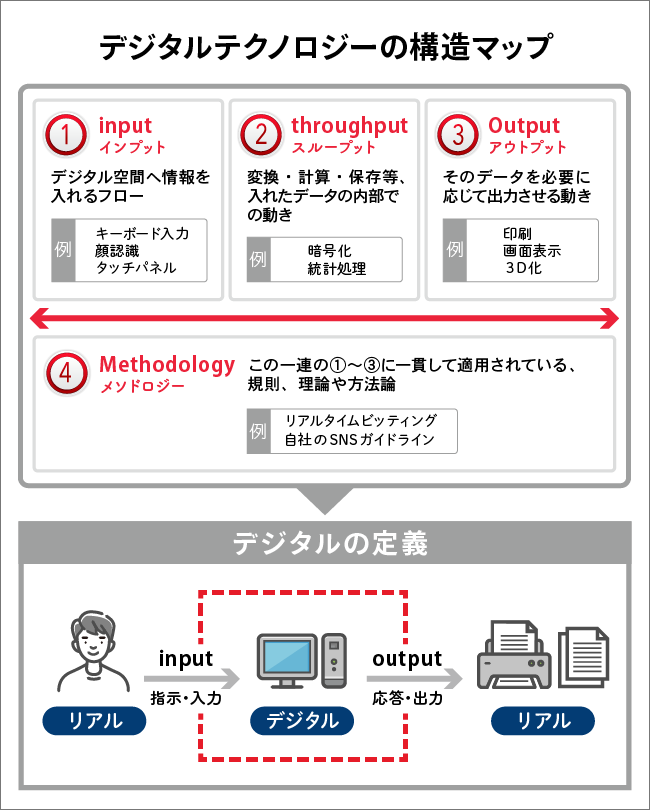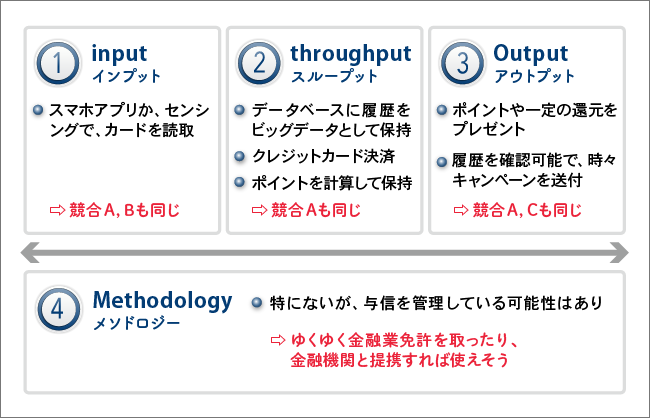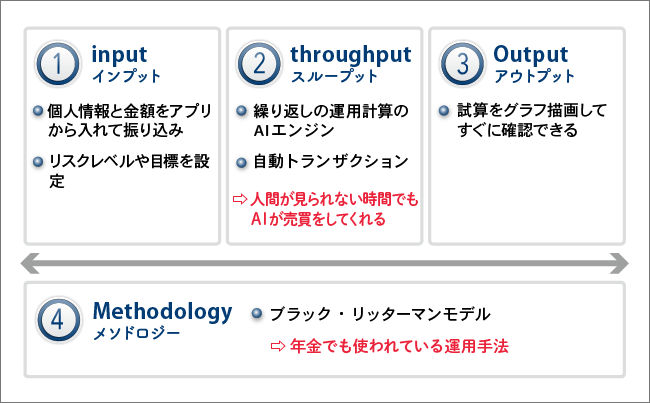Whether on new business projects, making investment decisions for ventures, or in everyday business negotiations, opportunities to encounter unfamiliar digital technologies are increasing, aren't they?
Of course, you wouldn't work without any understanding of the technology itself. But does that mean you need to analyze the underlying fundamental theories or the contents of the programs? Determining how much digital technology a business professional should understand is a very difficult question.
This time, we introduce fundamental concepts about digital technology and a framework for evaluating it.
"What is Digital?" Understanding the Fundamentals of Digital
First, let's consider how we perceive "digital"—a fundamental premise for understanding digital technology.
It's a somewhat vague question, but if someone asked you, "What is digital?" how would you answer? Many people probably haven't thought deeply about it.
I define digital as "changing the space of information to eliminate constraints." Let me explain.
Beyond the "real space" we inhabit, there exists a "digital space" where information flows—places like inside computers, devices, or cloud storage.
Within this digital space, information can be stored according to rules different from those in the real space. We perceive this as outputting that information onto screens of real-space devices or printed materials, which we then view.
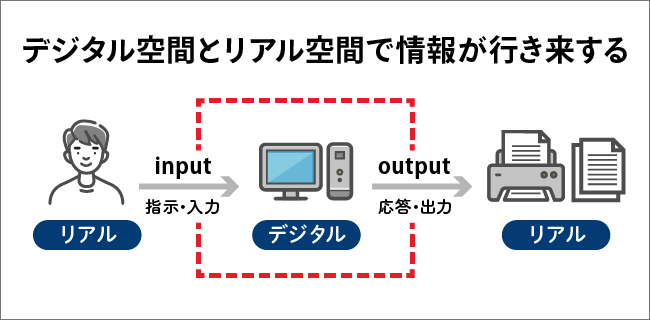
The Concept of Space in Digital
For example, a physical book requires space equivalent to the number of its pages. However, a tablet like a Kindle can store vast amounts of information—equivalent to several bookshelves—according to the device's capacity and storage rules, allowing you to read it on its screen.
If we printed every article from this Web Dentsu Inc. News, it would amount to an enormous number of pages. However, by storing the article information within the digital space of the internet, we can access it via a URL—a rule for specifying the information's location—and read it on smartphone or computer screens.
I believe this far exceeds the limitations of information imposed by physical space.
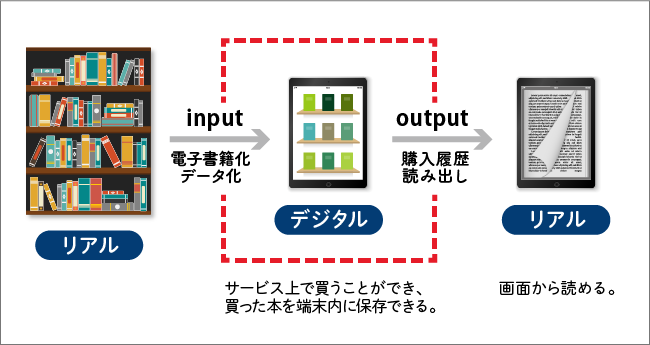
An image of Kindle when viewed as a bridge between real-world and digital-space information. User experience (UX) in digital services can fundamentally be expressed through this flow.
The common thread is that information is "input" into the digital space, undergoes "transformation, calculation, or storage," and is then "output" into the physical space where we can see it.
The seventh edition of the Kojien dictionary defines "digital" as "representing a quantity or data as a finite sequence of digits (e.g., binary numbers)."
Quantities or data in the analog real world we inhabit don't suddenly become binary numbers. Someone inputs them into the digital space, converts them to binary, performs calculations on that binary, then converts the results back to analog, outputting them in a form we can perceive.
When considering digital technology, this
"input" → "computation" → "output"
is a crucial point that applies to everything. No matter how complex the digital technology, remember that its essence is universal.
Analyzing digital technology by dividing it into four parts in the "Digital Technology Structure Map"
Keeping the aforementioned perspective in mind, we organized digital technology for analysis as shown in the diagram below. I call this diagram the "Digital Technology Structure Map."
Digital technology is divided into the following four parts:
① Input: The input component
② Throughput: The part that performs operations and calculations
③ Output: The part that produces results
④ Methodology: Rules, theories, and methodologies applied to the whole
After breaking down each element within the service, we conduct in-depth analysis for each part. This involves comparing it to competitors, searching for and gathering general information, investigating what it specifically entails, and examining whether there are any issues ( ).
Assessing the service's usefulness and potential
Let's introduce key points for utilizing the "Digital Technology Structure Map" by analyzing three actual examples.
■ Case Study: Payment System Service [Competitor Comparison]
After decomposing this payment service into four parts and comparing it with competing services, we found that the flow from ① to ③ was almost identical to competitors, revealing no notable strengths.
In other words, it lacks technological originality.
For such services, competitiveness should be built through sales efforts to stores during implementation, marketing and branding, alliances with other value chains, and incentive design.
Point!
・Even if you don't know all the details of the system or technology itself, write down what you do know and compare it with competitors.■Case of Fintech AI Asset Management Service [Simple Information Gathering]
Next, let's look at a recently popular fintech service where AI automatically manages assets.
When I searched because I didn't know the calculation model used by this service, I found it was very standard, employing the same investment mechanism as pensions. There doesn't seem to be any uniqueness in the theoretical part of growing assets.
Conversely, this means they adopt a tried-and-true theoretical approach, offering stability. Deposit processing and graph visualization are now standard features across services. The part where the service delivers results (i.e., grows the assets entrusted to it) is the intermediate transaction management. Therefore, we see that this service's strength lies in its transaction management, constantly adjusted by the AI.
To enhance the competitiveness of this business from the analytical perspective above, the growth points lie in either: - Digging deeper into this AI strength to further increase its value. - Or improving the service in the input/output areas on both sides, which are analog services or commonly found in other fintech services and currently lack competitive edge.
Point!
・Identify and analyze points of strength.
・Don't think about technical details from the start; only look up unfamiliar words when they appear.
■ Case Study: Lost Item Prevention Device [Deep Dive into Key Points]
Finally, let's look at a tag and app-based loss prevention service. You attach a tag to items you're likely to forget, like a bag, and it alerts you when you move a certain distance away from your smartphone.
This service leverages a network effect among users, relying on people's goodwill. It not only alerts users to their own lost items but also, through a mutual aid mechanism, notifies others about lost items. This creates an economic ecosystem where scale drives business growth—an excellent model for business expansion.
Since it can collect vast amounts of data, this lost-item notification system has potential for application in other areas. For example, enhancing throughput and output could lead to uses like crime prevention or data-driven marketing, opening possibilities for building and scaling different businesses.
Key Point!
・Once you identify areas with potential, it's crucial to brainstorm and expand those ideas.
By dividing it into these four parts as described above, you can roughly determine where the service's originality lies, how useful it is, and where potential growth points exist.
Finally, this "Structure Map" framework is not a technical analysis of the service itself. Therefore, if the service content is misunderstood, it becomes unusable.
We hope it serves as a useful first step for organizing "digital technologies that seem confusing at first glance."
This concludes the final installment of this series. Focusing on the theme of Business Development × Digital Technology, I've shared simplified versions of some of my know-how and perspectives. Thank you to everyone who read along.
※Note: We plan to publish a book next year that delves deeper into the topics covered in this series. It will explore aspects not covered in the articles, methods for gaining a more precise understanding of the technology, and how to integrate this understanding into business strategy planning. Furthermore, it will cover how to effectively question engineers/researchers who possess the technology and how to explain it effectively within your organization. Please look forward to it.



